millenium
Harmless

Posts: 2
Registered: 27-5-2011
Member Is Offline
Mood: No Mood
|
|
isopropyl chloride
hello, this is my first post. I was wondering if I can add a solution of boiled down vinegar (to concentrate acetic acid) and table salt (NaCl
although I have some KCl) to 70% USP standard isopropyl alchohol to create isopropyl chloride which I can then just heat gently at ~33 degrees Celsius
(Bp of isopropyl chloride is 35) and collect the vapor or something.
Please, I know it is easier to use HCl or something but I would just like to know if this would work. I already know the yield will be also really
small because acetic acid is weak acid, and maybe perhaps some competition with acetate ion to form ester or something? I am not sure. If any of you
pros see something wrong right away with this please tell me.

thank you
|
|
|
UKnowNotWatUDo
Hazard to Self
 
Posts: 96
Registered: 30-6-2010
Member Is Offline
Mood: No Mood
|
|
Well I can definitely tell you that this procedure will not work for you. Even if you used anhydrous isopropanol and concentrated hydrochloric acid,
you would need an activator like zinc chloride because isopropanol is a secondary alcohol. But even if you had zinc chloride in the reaction mixture
that you proposed, you wouldn't get the desired product. You really need proper reagents and equipment to conduct this experiment. Out of curiosity
may I ask what you want the isopropyl chloride for?
|
|
|
mario840
Hazard to Others
  
Posts: 229
Registered: 20-1-2010
Member Is Offline
Mood: No Mood
|
|
Isopropanol + conc. HCl + ZnCl2 ----> reflux , secondary alcohols turn into alkyls halogens quick (look at Lucas test) , the harderst to turn is
primary , of course if you have SOCl2 , PCL3 or PCl5 , yield will be higher , i don't ask you why you want these reagent beacuse this question is
stupid , you can make even sarin i don't care.
|
|
|
Nicodem
|
Thread Moved
27-5-2011 at 23:49 |
bbartlog
International Hazard
    
Posts: 1139
Registered: 27-8-2009
Location: Unmoored in time
Member Is Offline
Mood: No Mood
|
|
As already noted, what you propose won't work. There are at least two books in the forum library that have preps for isopropyl chloride. I would look
up one of those. Also it has been discussed in other threads. I have done the this synthesis albeit with kind of poor yield (44% was my highest... too
much water, not enough ZnCl2 I think). If you have the gear (which based on your, ah, extremely OTC proposal I'm guessing you don't) I recommend
trying to bubble HCl gas into a solution of isopropyl alcohol and ZnCl2. Even if it's not fully dry you'll still eliminate most of the water from the
reaction inputs.
Finally, I don't know how you propose to 'collect the vapor', but you kind of want an ice water cooled condenser for this. Not that isopropyl chloride
is highly toxic but you'll just be smelling up the environment and losing your product if you don't.
|
|
|
millenium
Harmless

Posts: 2
Registered: 27-5-2011
Member Is Offline
Mood: No Mood
|
|
riiiiight, I learned about this zinc chloride stuff... hmm
I dont need this chemical I was just looking around in my cabinet and was thinking and maybe thought this was possible haha. I have beakers and pipets
and vials but nothing gigantic like vaccum system or fractional distillation setup. I was just wondering and trying to explore the chemistry about
why.
Yes, I remember chloride is worse leaving group than Bromine or Iodine so it wont leave without help.... riiight I remmeber now
BTW, i just got out of first year university, taking organic chemistry course right now in the summer and learning about all these mechanisms and
thought it would be cool to apply them
dont make fun of me T_T.
|
|
|
ItalianChemist
Hazard to Others
  
Posts: 180
Registered: 26-1-2011
Location: Italy
Member Is Offline
Mood: No Mood
|
|
You need dry reagent, use HCl gas(dry), and a CaCl2 trap...I think making isoprpyl bromide is more simple, using bromine and red phosphorous
|
|
|
entropy51
Gone, but not forgotten
    
Posts: 1612
Registered: 30-5-2009
Member Is Offline
Mood: Fissile
|
|
Quote: Originally posted by ItalianChemist  | | You need dry reagent, use HCl gas(dry), and a CaCl2 trap...I think making isoprpyl bromide is more simple, using bromine and red phosphorous
|
Why would anyone waste bromine and phosphorus on that?
Quote: Originally posted by Nicodem  | Isopropyl bromide
200ml of 35% H2SO4 was boiled down to a volume of approximately 70ml (didn’t want to waste conc. H2SO4 by diluting it so I rather concentrated the
cheap diluted one to the concentration of about 75%). This sulfuric acid was then added drop wise from an addition funnel to 75ml of isopropanol while
stirring. Meanwhile portions of sodium bromide were added from time to time, 95g in total. The addition of H2SO4 was regulated in a way to keep the
temperature of the mixture about 20°C (cooling is advised). The reaction mixture was left overnight and the next day it was distilled from a boiling
water bath. The fraction distilling at 65°C was collected. The approximately 70ml of heavy liquid was washed with 2*70ml water to remove isopropanol,
dried over CaCl2 and filtered. It amounted to 84.3g of a high density, volatile, colorless liquid (76% of theory). |
|
|
|
bbartlog
International Hazard
    
Posts: 1139
Registered: 27-8-2009
Location: Unmoored in time
Member Is Offline
Mood: No Mood
|
|
| Quote: | | You need dry reagent, use HCl gas(dry), and a CaCl2 trap |
No, this is not some anhydrous reaction a la preparing a Grignard (remember it can even be done with aqueous HCl). Traps, pre-drying of reagents etc.
may increase yield by removing water, but substantial quantities are going to be put back in anyway as the chloride is formed - one mole per mole of
product. So trying to remove some last few % of water is likely to be a poor use of time.
|
|
|
Waffles SS
Fighter
    
Posts: 1000
Registered: 7-12-2009
Member Is Offline
|
|
I think this is possible to use @entropy51 suggested method, for making Isopropyl Chloride instead of Isopropyl bromide(NaCl + H2SO4 + IPA) .
I like to test this method but i will use excess Zinc chloride instead of sodium chloride(For making HCl )
|
|
|
Ionic Chemist
Harmless

Posts: 39
Registered: 22-3-2011
Member Is Offline
Mood: Polymerizing
|
|
Production of 2-chloropropane from IPA and NaCl
Hey everyone long time since I've made a post, well lets get to business.
I'm thinking of synthesizing 2-chloropropane for creation of 2,3-dimethyl-2-butanol in a "one pot" alkylation synthesis from acetone. First thing that
came to my mind to try was to distil a mixture of OTC 70% isopropyl alcohol, household sodium chloride and regular lab grade sulfuric acid.
However, after further research I found out that even though the reaction is possible, such as to use the sulfuric acid to produce hydrochloric acid
in situ which could then go on to react with the IPA to produce the 2-CP, the competing E1 elimination reaction would certainly decrease
yields by converting the IPA to propene.
So to add a spin to the procedure, instead of just adding the alcohol, salt and acid then trying to distill off any product I've decided to try the
synthesis like a large scale Lucas' Test. But the problem I have now is that I do not have any zinc chloride to act as the primary catalyst. To remedy
this situation I'm contemplating the addition of zinc sulfate to the reagent mixture and refluxing the entire mixture for 1-2 hours.
Hopefully if I'm correct the zinc sulfate in the mixture will continuously transition from sulfate to chloride during the reaction with the excess
hydrochloric acid formed, providing the catalyst for the alkylation of the IPA, meanwhile the sulfuric acid will dehydrate the mixture, pushing the
equilibrium to the right in favor of production of the 2-CP.
If everything goes as planned and I do get some product, I'll do the usual chemical washing procedure with water and
concentrated sodium chloride solution. Then I will dry the product with anhydrous sodium carbonate powder. Afterwards I will try my hand at producing
the alcohol by mixing the 2-CP with acetone and sodium, while refluxing the mixture; then after completion, a little bit of acid hydrolysis to obtain
the relatively pure 2,3-dimethyl-2-butanol.
If anyone can and wants to help and improve my procedure I will gladly accept any assistance.
Thank You ........
|
|
|
Waffles SS
Fighter
    
Posts: 1000
Registered: 7-12-2009
Member Is Offline
|
|
http://www.sciencemadness.org/talk/viewthread.php?tid=16441
|
|
|
Nicodem
|
Threads Merged
3-8-2012 at 06:38 |
Nicodem
Super Moderator
      
Posts: 4230
Registered: 28-12-2004
Member Is Offline
Mood: No Mood
|
|
Quote: Originally posted by Ionic Chemist  | | Afterwards I will try my hand at producing the alcohol by mixing the 2-CP with acetone and sodium, while refluxing the mixture; then after
completion, a little bit of acid hydrolysis to obtain the relatively pure 2,3-dimethyl-2-butanol. |
Do you mind giving us the reference for this reaction?
…there is a human touch of the cultist “believer” in every theorist that he must struggle against as being
unworthy of the scientist. Some of the greatest men of science have publicly repudiated a theory which earlier they hotly defended. In this lies their
scientific temper, not in the scientific defense of the theory. - Weston La Barre (Ghost Dance, 1972)
Read the The ScienceMadness Guidelines!
|
|
|
Ionic Chemist
Harmless

Posts: 39
Registered: 22-3-2011
Member Is Offline
Mood: Polymerizing
|
|
Production of 2,3-dimethyl-2-butanol
Actually there is no true reference, this procedure is as of result of me not having any etherial solvent to use and create a grignard reagent to
proceed with the alkylation. Due to this, I combined the process of making grignard reagents with that of synthesizing alkyl-lithium compounds and
nucleophilic attack on the carbonyl compound.
This is how I think it will work out: the acetone and 2-CP are anhydrous reagents. When the reagents are mixed they simply just dissolve and form a
homogeneous mixture. When the sodium is added, the sodium preferentially reacts with the 2-CP yielding, for a fleeting instant, propan-2-ylsodium
(a.k.a. isopropyl sodium) and sodium chloride. The propan-2-ylsodium then commences nucleophilic attack, in situ, on an
acetone molecule. This results in the formation of [(2,3-dimethylbutan-2-yl)oxy]sodium (a.k.a sodium 2,3-dimethyl-2-butoxide). By refluxing, the
sodium keeps a freshly exposed surface while in the mixture, promoting the formation of more sodium 2,3-dimethyl-2-butoxide. After the reaction has
reached completion I will then hydrolyze the alkoxide produced with an acid solution, to yield the final product of 2,3-dimethyl-2-butanol.
Now the drawback to the process is that as soon as all the 2-CP is reacted with the acetone and has produced the alkoxide, the sodium will then
attack the acetone in a type of aldol condensation reaction producing diacetone alcohol; which then due to heat and rearrangement will produce mesityl
oxide and isophorone. (You win some you lose some)
So therefore, I will have to moderate the amount of sodium used in the experiment to limit the formation of unwanted side products and keep the
alcohol formed relatively pure. Or else, I will have to reform the solid butoxide, and using a solvent such as isopropyl alcohol dissolve out the
byproduct impurities, then "rehydrolyze" the alkoxide to produce the purified alcohol.
Thank You.....
|
|
|
barley81
Hazard to Others
  
Posts: 481
Registered: 9-5-2011
Member Is Offline
Mood: No Mood
|
|
You should take into account that the enolate of acetone may form, as well as reduction products. This can do Sn2 substitution on the isopropyl
chloride and form MIBK.
|
|
|
Ionic Chemist
Harmless

Posts: 39
Registered: 22-3-2011
Member Is Offline
Mood: Polymerizing
|
|
Quote: Originally posted by barley81  | | You should take into account that the enolate of acetone may form, as well as reduction products. This can do
Sn2 substitution on the isopropyl chloride and form MIBK. |
The part about the enolate forming. Remember that the enolate formation is responsible for the whole aldol condensation so yeah I did keep that in
mind. However, the premise of methyl isobutyl ketone forming is a quite new look at it.
I think the possibility is extremely low of that occurring, because remember it is in an alkylating environment and it does have an active carbonyl
group, so if any isopropyl sodium was present at that time the MIBK would be attacked to form [(2,3,5-trimethylhexan-3-yl)oxy]sodium (a.k.a. sodium
2,3,5-trimethylhexan-3-oxide) this could indeed be possible and maybe it would also be removed if I did the resolidification and solvent wash.
(Cool thinking barley81 unique perspective)
I just think the formation of MIBK in the first place would be a little remote because the only time that it would be able to form, is if there was a
higher acetone to 2-CP ratio in the mixture, but remember if the starting solution is equimolar then for each mole of 2-CP that is converted to
propan-2-ylsodium one mole of acetone will be attacked to yield the alkoxide.
Well I can't rule out side reactions going awry so I'll keep the idea in the back of my head and I'll report back with my experimental findings. If
anyone else would like to help your aid would be greatly appreciated.
Thank You.....
|
|
|
bbartlog
International Hazard
    
Posts: 1139
Registered: 27-8-2009
Location: Unmoored in time
Member Is Offline
Mood: No Mood
|
|
I can't speak to the feasibility of your second step. However, if the synthesis of isopropyl chloride ends up being problematic, you could try adding
activated alumina as a catalyst. It worked well for me (at least in the sense of greatly speeding up the reaction). Though the alumina does get
gradually attacked by the HCl, as far as I can tell.
The less you bet, the more you lose when you win.
|
|
|
Nicodem
Super Moderator
      
Posts: 4230
Registered: 28-12-2004
Member Is Offline
Mood: No Mood
|
|
Ionic Chemist, regarding the "second step", I can tell you that it is wishful thinking that has no support from the theory. I will not go into
details, because there is too much to explain and it would be too difficult to explain until you learn the reaction mechanisms and the corresponding
terminologies. You can do a bit of literature work yourself and learn many interesting concepts. It is always more of a challenge to learn by doing
literature work on a specific topic and then follow up with the new concepts you encounter on the way. As far as wishful thinking, it does have a
place in science, but in the form of imaginative and creative thinking, which means you need to temper it by using the scientific method.
The synthesis of isopropyl chloride is not something you want to do for an introduction to preparative chemistry. It will only cause you grief. Even
if you had ZnCl2 and an autoclave and did this by the literature procedure, as the one posted somewhere on this forum, you would still encounter the
unpleasant experience of isolating such a volatile compound. I suggest you to try first with something relatively simple like the synthesis of
isopropyl bromide or isopropyl iodide. There are also more references available for these two.
…there is a human touch of the cultist “believer” in every theorist that he must struggle against as being
unworthy of the scientist. Some of the greatest men of science have publicly repudiated a theory which earlier they hotly defended. In this lies their
scientific temper, not in the scientific defense of the theory. - Weston La Barre (Ghost Dance, 1972)
Read the The ScienceMadness Guidelines!
|
|
|
Ionic Chemist
Harmless

Posts: 39
Registered: 22-3-2011
Member Is Offline
Mood: Polymerizing
|
|
Update of experiment
Quote: Originally posted by Nicodem  | Ionic Chemist, regarding the "second step", I can tell you that it is wishful thinking that has no support
from the theory. I will not go into details, because there is too much to explain and it would be too difficult to explain until you learn the
reaction mechanisms and the corresponding terminologies. You can do a bit of literature work yourself and learn many interesting concepts. It is
always more of a challenge to learn by doing literature work on a specific topic and then follow up with the new concepts you encounter on the way. As
far as wishful thinking, it does have a place in science, but in the form of imaginative and creative thinking, which means you need to temper it by
using the scientific method.
The synthesis of isopropyl chloride is not something you want to do for an introduction to preparative chemistry. It will only cause you grief. Even
if you had ZnCl2 and an autoclave and did this by the literature procedure, as the one posted somewhere on this forum, you would still encounter the
unpleasant experience of isolating such a volatile compound. I suggest you to try first with something relatively simple like the synthesis of
isopropyl bromide or isopropyl iodide. There are also more references available for these two. |
Okay, thanks everyone for the constructive criticisms really appreciated. Now at Nicodem, I am aware of your Super Moderator status so I know that you
must have a good knowledge of chemistry from preparation to isolation etc. But don't be fooled by my Harmless status or the fact that I just joined SM
(relatively speaking). I have been practicing, researching and theorizing chemistry from an early age and I do have a grasp of the subject,
from simple orbital interactions to complex organic synthesis and rearrangement processes. So if you see it expedient to make evident the shortcomings
of my theory then for my sake don't hold back, you'd be surprised to know the type of information I can handle at this stage.
With that done I must say I have already synthesized isopropyl iodide, isopropyl bromide and one or two other alkyl halides, (primary) and
the reason I was trying to synthesize isopropyl chloride was to test and increase the bounds of my knowledge, in adaptability, to the of synthesis new
compounds; a bit of a challenge.
Now addressing my use of terminologies, I know that everything is not perfect pertaining to my use of all the terminologies, but I try my best to make
everything line up with what I am trying to achieve based on primary results and data. So me trying to synthesize the alcohol in the second step is
because I had already done a similar reaction on small scale with n-bromobutane, acetone and sodium and the aroma of the hydrophobic organic layer was
reminiscent of the 2-methyl-2-hexanol that I synthesized in a prior grignard reaction between the same organic reactants, and its physical properties
also 'lined up' with the same 2-methyl-2-hexanol.
If I have offended anyone on this site I am sincerely sorry, I did and do not intend to offend anyone by any means whatsoever.
BACK TO CHEMISTRY ............
The synthesis of 2-CP was a success, I only planned to collect about 10% of my initial volume of alcohol, 50ml after drying, worth of isopropyl
chloride due to the ineffectiveness of my three-bulbed allihn condenser and the volatility of the compound, but non the less, I collected
approximately 6ml of isopropyl chloride (after a wash to remove remaining isopropyl alcohol and acidic hydrogen halide impurities).
A flame test showed that the compound produced was a halogenated derivative of the isopropyl alcohol, evident be the sickly green color at the flame
base, and combustion also showed that the compound produced more soot (compared to the burning of IPA), implying that there was a higher
carbon to oxygen ratio when the distillate was burned. Slight fumes of what I perceive to be HCl were given of during combustion.
Next I will attempt to make the alcohol, hopefully even though this is a secondary halogenoalkane and it exhibits some steric hindrance (compared
to n-bromobutane) it will still be able to act as a proper alkylating agent when reacted with the sodium, to yeild the alkoxide after reaction
with the acetone. I have no doubt though that some of the 2-CP will undergo an E2 elimination reaction in that environment to produce some propene but
that should not be too much of a problem if the environmental factors are kept just right.
Below are a set of pictures I took meanwhile doing the experiment of producing the 2-chloropropane. (Left to right: Reflux apparatus consisting of
a 250cm3 distillation flask and a 5-bulbed allihn condenser. Biphasic layer produced after wash of distillate with cold water (top organic 2-CP layer,
bottom aqueous layer with isopropyl alcohol impurities). Organic layer after addition of sodium carbonate dessicant. Isopropyl chloride product sealed
in container with small amount of dessicant. Flame produced by combustion of IPA. Flame produced by burning of 2-CP.
Thank You ......
 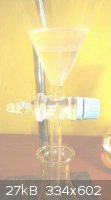 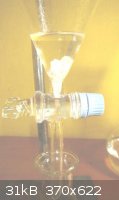 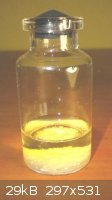 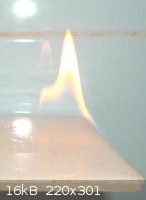 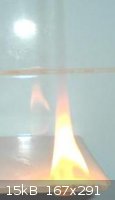
|
|
|
Nicodem
Super Moderator
      
Posts: 4230
Registered: 28-12-2004
Member Is Offline
Mood: No Mood
|
|
Quote: Originally posted by Ionic Chemist  | | Now at Nicodem, I am aware of your Super Moderator status so I know that you must have a good knowledge of chemistry from preparation to isolation
etc. But don't be fooled by my Harmless status or the fact that I just joined SM (relatively speaking). |
The forum status means nothing and if you knew me better you would know that I know almost nothing about chemistry. But I do have some clues about the
scientific method and some skills in doing literature work.
| Quote: | | I have been practicing, researching and theorizing chemistry from an early age and I do have a grasp of the subject, from simple orbital interactions
to complex organic synthesis and rearrangement processes. So if you see it expedient to make evident the shortcomings of my theory then for my sake
don't hold back, you'd be surprised to know the type of information I can handle at this stage. |
With all due respect to your skills and knowledge, I do have to remark that a hypothesis without references is not a hypothesis at all. What's more,
you put the conclusions in front of the experience.
| Quote: | | With that done I must say I have already synthesized isopropyl iodide, isopropyl bromide and one or two other alkyl halides, (primary) and
the reason I was trying to synthesize isopropyl chloride was to test and increase the bounds of my knowledge, in adaptability, to the of synthesis new
compounds; a bit of a challenge. |
That's just the kind of motivation I would like to see more on this forum. If you continue with such enthusiasm you can always count on our support.
| Quote: | | So me trying to synthesize the alcohol in the second step is because I had already done a similar reaction on small scale with n-bromobutane, acetone
and sodium and the aroma of the hydrophobic organic layer was reminiscent of the 2-methyl-2-hexanol that I synthesized in a prior grignard reaction
between the same organic reactants, and its physical properties also 'lined up' with the same 2-methyl-2-hexanol. |
A scientific mind would be very critical about your conclusions being done without supporting evidence. Did you isolate the product? Did you
characterize it? What was the yield and purity? Unless you can provide conclusive answers to these questions, you should not be doing any conclusions
of this nature.
| Quote: | | The synthesis of 2-CP was a success, I only planned to collect about 10% of my initial volume of alcohol, 50ml after drying, worth of isopropyl
chloride due to the ineffectiveness of my three-bulbed allihn condenser and the volatility of the compound, but non the less, I collected
approximately 6ml of isopropyl chloride (after a wash to remove remaining isopropyl alcohol and acidic hydrogen halide impurities).
|
A scientific mind would warn you that this description is of no value, because you do not provide the experimental part of the report.
| Quote: | | A flame test showed that the compound produced was a halogenated derivative of the isopropyl alcohol, evident be the sickly green color at the flame
base, and combustion also showed that the compound produced more soot (compared to the burning of IPA), implying that there was a higher
carbon to oxygen ratio when the distillate was burned. Slight fumes of what I perceive to be HCl were given of during combustion.
|
Such qualitative tests are indicative, but they are not conclusive. One conclusive test would be the boiling point measurement. Let me explain. We can
easily believe that you obtained isopropyl chloride, because we know from other reports that it forms in miserable yields even from refluxing
HCl in 2-propanol, but science is not about beliefs. There has been too many mistakes done merely due to a scientist believing something that someone
else later proved wrong.
| Quote: | | Next I will attempt to make the alcohol, hopefully even though this is a secondary halogenoalkane and it exhibits some steric hindrance (compared
to n-bromobutane) it will still be able to act as a proper alkylating agent when reacted with the sodium, to yeild the alkoxide after reaction
with the acetone. I have no doubt though that some of the 2-CP will undergo an E2 elimination reaction in that environment to produce some propene but
that should not be too much of a problem if the environmental factors are kept just right. |
Your optimism can be either constructive or destructive. In this case you are leaning on the destructive side. Also, focusing on one issue is
paramount to blindness. The E2 elimination is of no practical relevance when you do a reality check by the literature. There is a reason why synthetic
chemists struggle so much to understanding reaction mechanisms. The reason is exactly so that they do not fall in such distorted focus pitfalls.
You do know that acetone reacts with sodium via pinacol coupling? You do know, that even if an alkylsodium forms, unlike the grignards, it enolizes
enolizable ketones? Do you have any reference where an s-alkyllithium preparatively adds to acetone or any other enolizable ketone? Because
if it does not work with the relatively covalent alkyllithiums, you can bet it wont work with the more polarized alkylsodium. You do know that the
scope and limitations of the Barbier reaction, which would be the name of this reaction, is extremely narrow? Actually, so narrow that I'm not aware
of examples where sodium would be used, or s-alkyl chlorides and ketones being the reaction partners.
These are just a few issues you should be considering and doing literature work on them. Yet, this is not to say that the reaction can not produce the
target compound, but it goes to say that chances are against it being the main product, or even a detectable product. Still, if you prove me
wrong and manage to develop a preparative reaction of this kind, I will be the first to congratulate you.
PS: Don't take my reply as offensive, because it certainly is not such. When I want to be offensive, I ignore posts. When I reply it is only because I
want someone to learn something that I consider useful for his progress.
…there is a human touch of the cultist “believer” in every theorist that he must struggle against as being
unworthy of the scientist. Some of the greatest men of science have publicly repudiated a theory which earlier they hotly defended. In this lies their
scientific temper, not in the scientific defense of the theory. - Weston La Barre (Ghost Dance, 1972)
Read the The ScienceMadness Guidelines!
|
|
|
Waffles SS
Fighter
    
Posts: 1000
Registered: 7-12-2009
Member Is Offline
|
|
Vogel-PracticalOrganicChemistry3rdEd(page 272)
(Alkyl chloride from Secondary alcohol)
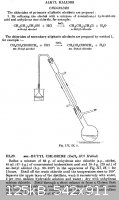
[Edited on 29-11-2012 by Waffles SS]
|
|
|